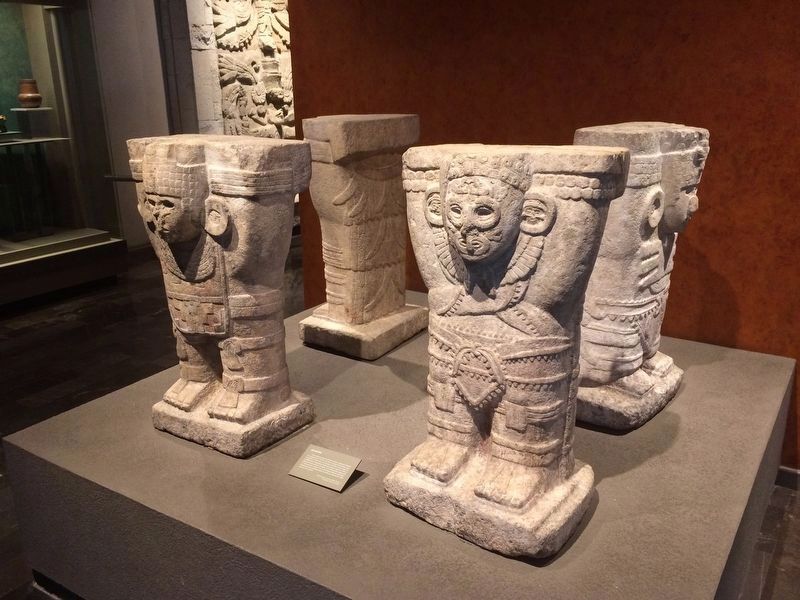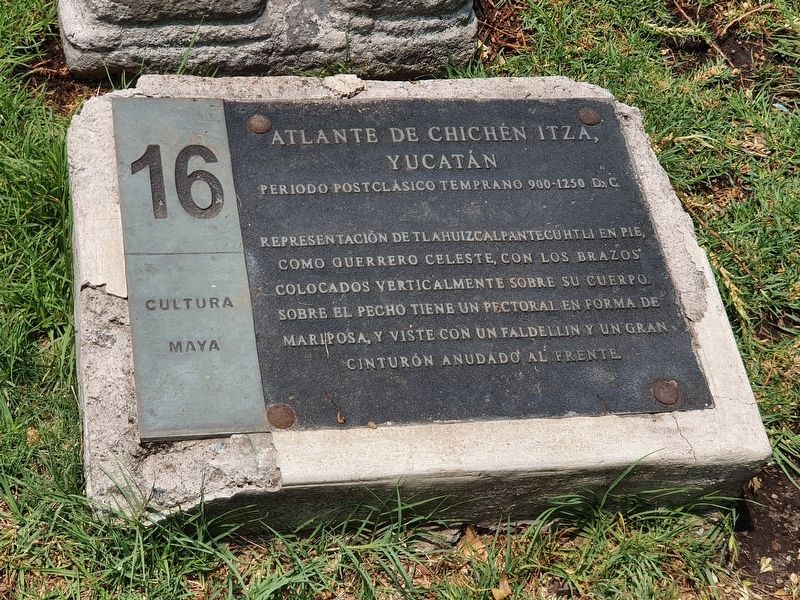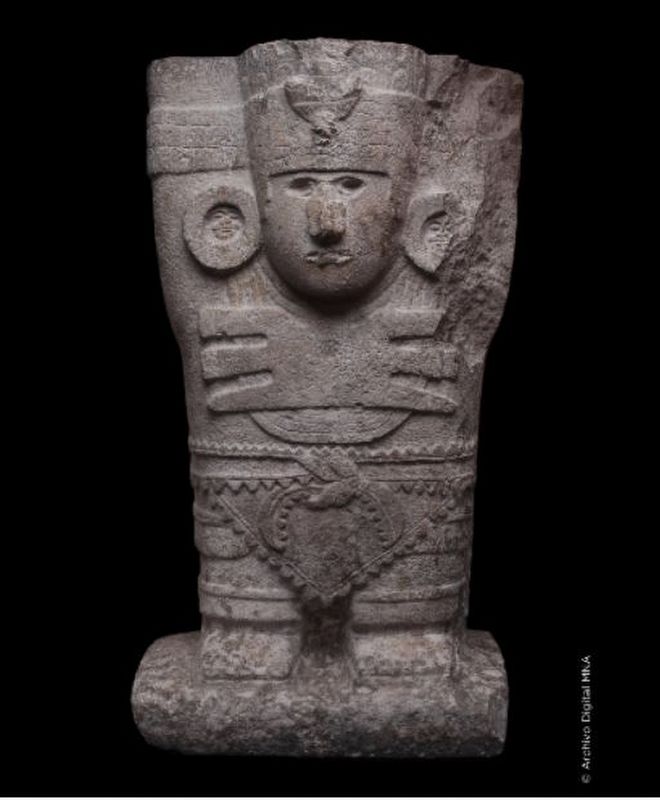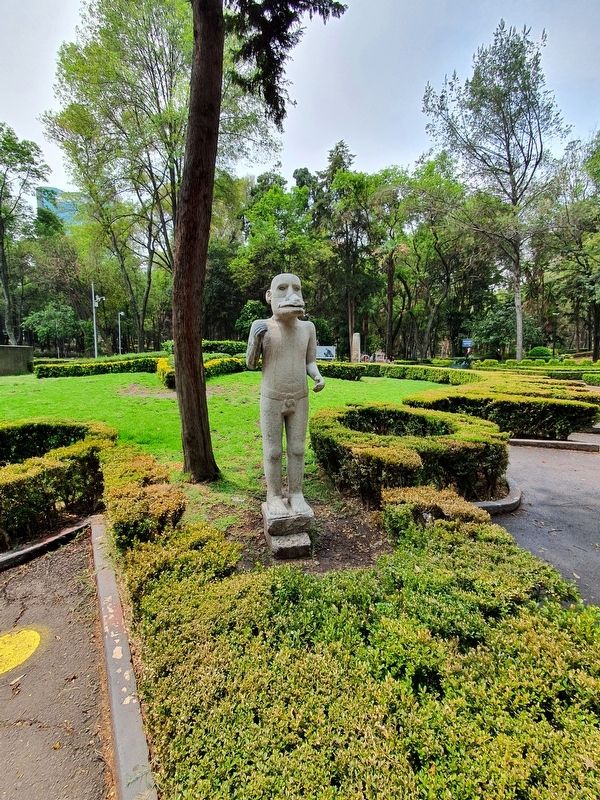Colonia Extremadura Insurgentes in Ciudad de México, Mexico — The Valley of Mexico (The Central Highlands)
Atlante from Chichén Itzá, Yucatán
Periodo Postclásico Temprano 900-1250 D.C.
Representación de Tlahuizcalpantecuhtli en pie, como guerrero celeste, con los brazos colocados verticalmente sobre su cuerpo. Sobre el pecho tiene un pectoral en forma de mariposa, y viste con un faldellin y un gran cinturón anudado al frente.
Atlante from Chichén Itzá, Yucatán
Early Postclassic Period 900-1250 AD
Representation of Tlahuizcalpantecuhtli standing as a celestial warrior, with arms placed vertically on his body. On his chest he has a butterfly-shaped pectoral, and wears a short skirt and a large belt knotted in the front. (Marker Number 16.)
Topics. This historical marker is listed in these topic lists: Anthropology & Archaeology • Parks & Recreational Areas.
Location. 19° 22.7′ N, 99° 10.698′ W. Marker is in Ciudad de México. It is in Colonia Extremadura Insurgentes. Marker can be reached from Avenida Insurgentes Sur just south of Avenida Porfirio Díaz, on the right when traveling south. Touch for map. Marker is in this post office area: Ciudad de México 03740, Mexico. Touch for directions.
Other nearby markers. At least 8 other markers are within walking distance of this marker. Tláloc from Castillo de Teayo, Veracruz (within shouting distance of this marker); Mask of the Chaac Deity, Kabah, Yucatán (within shouting distance of this marker); Quetzalcoatl Base Engraving (within shouting distance of this marker); Serpent Columns (within shouting distance of this marker); Stela of Halch, Huinic (within shouting distance of this marker); Dolores Asúnsolo López Negrete (within shouting distance of this marker); Benito Juárez (about 90 meters away, measured in a direct line); Kukulkán Panel (about 90 meters away). Touch for a list and map of all markers in Ciudad de México.

Photographed By J. Makali Bruton, January 25, 2017
2. Atlantes from Chichén Itzá
These atlantes from Chichén Itzá are at the Mexican National Anthropology Museum. The atlante described by the marker is on the far right. The associated text reads:
Atlantes
Estas esculturas, que sostenían una mesa o altar en el Templo de los Jaguares, de Chichén Itzá, tienen caracteristicas toltecas que demuestran las relaciones que existían entre Tula y esta ciudad. Por las diferencias en taparrabos, bandas, pectorales y adornos, como el del pectoral de mariposa o el perro en el collar, podria tratarse de la representación de guerreros o de órdenes militares. Se ha interpretado que estos personajes tenian la mision de mantener los cielos separados de la tierra.
Epoca Postclasico Temprano (1000-1250 d.C.)
Procedencia Chichén ltzá, Yucatán
English translation:
Atlantes
These sculptures, which held a table or altar in Chichen Itza's Temple of Jaguars, have Toltec features that demonstrate the relationships that existed between Tula and this city. Because of differences in loincloths, bands, chestpieces and ornaments, such as that of the butterfly pectoral or the dog on the collar, it could be the representation of warriors or military orders. It has been interpreted that these characters had the mission of keeping the heavens separate from the earth.
Early Postclassic Era (1000-1250 d.C.)
Provenance: Chichen ltza, Yucatan
Estas esculturas, que sostenían una mesa o altar en el Templo de los Jaguares, de Chichén Itzá, tienen caracteristicas toltecas que demuestran las relaciones que existían entre Tula y esta ciudad. Por las diferencias en taparrabos, bandas, pectorales y adornos, como el del pectoral de mariposa o el perro en el collar, podria tratarse de la representación de guerreros o de órdenes militares. Se ha interpretado que estos personajes tenian la mision de mantener los cielos separados de la tierra.
Epoca Postclasico Temprano (1000-1250 d.C.)
Procedencia Chichén ltzá, Yucatán
Atlantes
These sculptures, which held a table or altar in Chichen Itza's Temple of Jaguars, have Toltec features that demonstrate the relationships that existed between Tula and this city. Because of differences in loincloths, bands, chestpieces and ornaments, such as that of the butterfly pectoral or the dog on the collar, it could be the representation of warriors or military orders. It has been interpreted that these characters had the mission of keeping the heavens separate from the earth.
Early Postclassic Era (1000-1250 d.C.)
Provenance: Chichen ltza, Yucatan
Credits. This page was last revised on May 9, 2021. It was originally submitted on May 4, 2021, by J. Makali Bruton of Accra, Ghana. This page has been viewed 265 times since then and 38 times this year. Photos: 1. submitted on May 4, 2021, by J. Makali Bruton of Accra, Ghana. 2, 3, 4. submitted on May 5, 2021, by J. Makali Bruton of Accra, Ghana.


